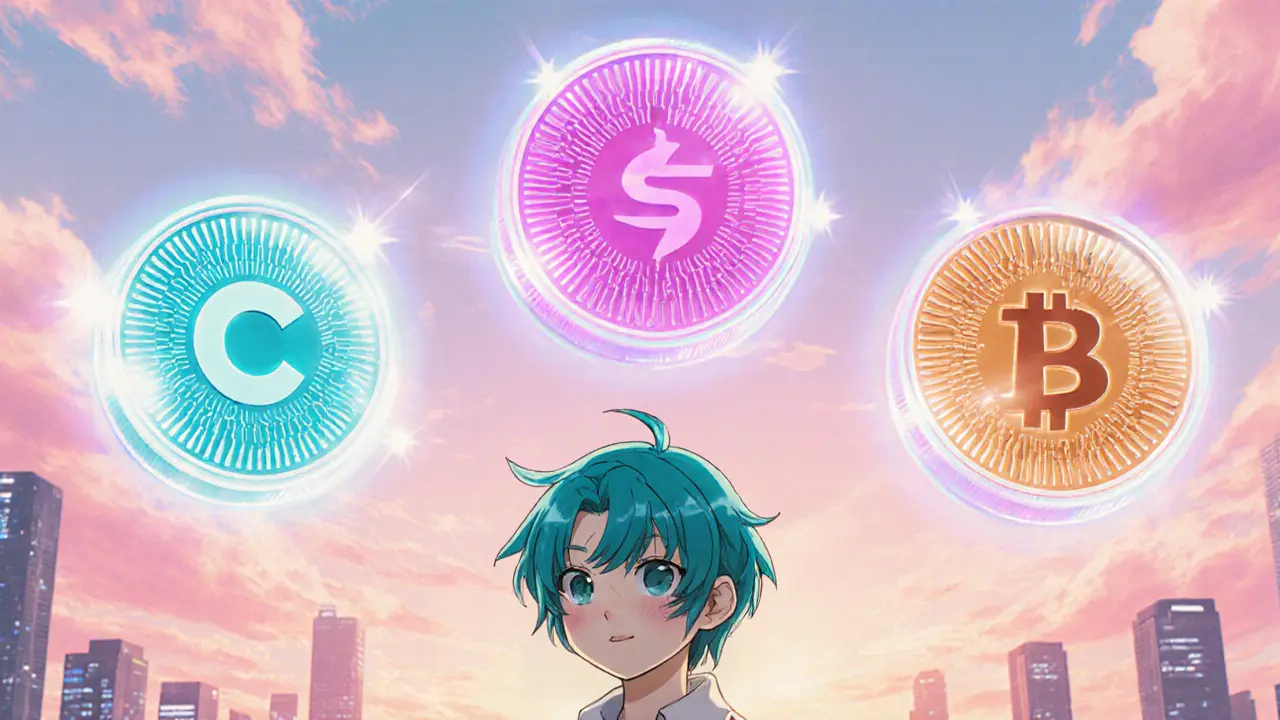Robin (ROBIN) Token Comparison Tool
This tool compares the three variants of Robin (ROBIN) tokens across different blockchains. Each variant has different contract addresses, price points, and liquidity levels.
Cronos ROBIN
- Token Standard ERC-20
- Contract Address Not publicly listed
- Price (Sep 2025) $0.000003
- 24h Volume $4,200
- Exchange Listing None
- Community Very Low
Solana ROBIN
- Token Standard SPL
- Contract Address Mint address
- Price (Sep 2025) $0.000015
- 24h Volume $1,200
- Exchange Listing None
- Community None
Crypto.com ROBIN
- Token Standard ERC-20
- Contract Address 0x664E4b17EA045fE92868821F3eE0a76a5dB38166
- Price (Sep 2025) $0.000002
- 24h Volume $800
- Exchange Listing Learn2Earn only
- Community None
Key Insights
All three variants share similar risk profiles: low price, minimal volume, and no active ecosystem. The Cronos version is the most visible on price trackers, while Solana and Crypto.com Chain variants have no active community or exchange listings.
Warning: Robin tokens are highly speculative with no real utility or liquidity.
Ever stumbled on a tiny token called Robin crypto and wondered if it’s worth a look? The name pops up on a handful of low‑volume exchanges, but the reality is far messier than a single “coin”. In fact, Robin (ROBIN) is not one token at all - it’s a family of meme‑style tokens scattered across three blockchains, each with its own contract address, community vibe and almost nonexistent liquidity. This guide breaks down the variants, shows you where the price lives today, highlights the biggest red flags, and tells you exactly how (and whether) you can actually buy one.
What is Robin (ROBIN)? The many faces behind the name
At its core, Robin is marketed as a community‑driven meme token. The most documented version launched on the Cronos blockchain in late 2023, branding itself around a fictional superhero that “protects the Cronos universe”. A separate version lives on Solana, touting low‑fee, high‑speed transfers. A third variant appears on the Crypto.com Chain, supposedly tying into Crypto.com’s payment ecosystem.
Because each version has its own smart‑contract address, price feed, and community (or lack thereof), investors often confuse them. The CoinGecko and CoinPaprika entries treat them as distinct assets, yet they all share the same “ROBIN” ticker, which fuels the confusion.
Technical specs - contract addresses and blockchain quirks
Understanding the tech is the first step to avoiding a costly mistake.
- Cronos version: Runs on the Ethereum‑compatible Cronos chain. The exact contract address isn’t widely published, but the token can be verified on the official Cronos explorer (cronos.org). It follows the ERC‑20 standard, meaning any wallet that supports ERC‑20 tokens will display it.
- Solana version: Uses Solana’s SPL token standard. The contract address is hidden behind a short alias on Solana explorers, but you can locate it via the token’s mint address on solscan.io.
- Crypto.com Chain variant: Confirmed contract address is
0x664E4b17EA045fE92868821F3eE0a76a5dB38166. It is an ERC‑20 style token on the Crypto.com Chain, compatible with MetaMask when configured for the chain.
From a developer’s perspective, none of these versions show any unique on‑chain functionality - they’re plain token contracts without staking, governance, or utility modules. In other words, the only thing they “enable” is the transfer of a number that holds almost no real value.

Market performance - price, volume and why the numbers look weird
Price data for Robin tokens is notoriously volatile and often contradictory. Below is a snapshot from the most reliable trackers as of September302025:
- Cronos Robin: $0.000003USD on Binance (spot price), 24‑hour volume around $4,200, market cap reported as $0 (meaning the token is not listed on any major exchange ranking).
- Solana Robin: $0.000015USD on LiveCoinWatch, 24‑hour volume under $1,500.
- Crypto.com Chain Robin: $0.000002USD on Coinbase, trading pairs are “Learn2Earn” promotions rather than open market orders.
Why do these figures swing wildly? Two reasons:
- Liquidity is almost nil. Most trades occur on tiny decentralized pools where a single buy or sell can shift the price by >10%.
- Data aggregators treat the three tokens as separate assets, so price averages across platforms are meaningless.
In practice, a trader will see a price quote, place an order, and end up with a slippage that wipes out any potential profit.
How to acquire Robin - a step‑by‑step for the curious (and cautious)
If you’re still set on buying, follow these exact steps. Remember, you’re essentially paying for a speculative badge, not a functional asset.
- Choose the blockchain you want - most people pick Cronos because it has the most visible price.
- Set up a compatible wallet:
- For Cronos - MetaMask with the Cronos RPC (https://evm-cronos.org).
- For Solana - Phantom or Sollet.
- For Crypto.com Chain - MetaMask with Crypto.com RPC.
- Buy a base coin on a major exchange (e.g., CRO for Cronos, SOL for Solana, or CCT for Crypto.com Chain).
- Bridge the base coin to the target network using a trusted bridge (Cronos Bridge, Wormhole, or Crypto.com Bridge).
- Swap the base coin for ROBIN on a decentralized exchange (DEX) that lists the pair, such as VVS Finance (Cronos) or Raydium (Solana). The swap will usually be a “learn‑to‑earn” promotion that gives you a handful of ROBIN for free.
- Confirm the token appears in your wallet by adding the contract address manually.
Because most DEXs require you to set a high slippage tolerance (often >5%), you may lose a significant portion of the token right away.
Risks, red flags and why most experts stay away
Every crypto investor should ask three hard questions before putting money into a meme token. Robin fails all three.
- Liquidity risk: Daily volume stays under $6,000 across all versions. Trying to sell a few thousand dollars worth of ROBIN will move the market price dramatically.
- Community risk: No active Reddit threads, no Discord, and the official site (robincronos.com) offers no roadmap or developer documentation. Without a community, the token cannot sustain price pressure.
- Regulatory risk: Though the token’s tiny size keeps it off most regulators’ radars, any future classification as a security could freeze trading on the few DEXs that host it.
In short, Robin is a high‑risk, low‑potential speculative token. Most financial analysts label it a “dead‑coin candidate” because similar micro‑cap meme tokens disappear within a year, according to Messari’s 2023 Crypto Thematic Report.

Comparison of the three ROBIN variants
| Attribute | Cronos | Solana | Crypto.com Chain |
|---|---|---|---|
| Token standard | ERC‑20 (Cronos‑compatible) | SPL (Solana) | ERC‑20 (Crypto.com Chain) |
| Contract address (example) | Not publicly listed | Mint address on Solscan | 0x664E4b17EA045fE92868821F3eE0a76a5dB38166 |
| Typical price (Sept2025) | $0.000003 | $0.000015 | $0.000002 |
| 24‑h volume | ~$4,200 | ~$1,200 | ~$800 |
| Major exchange listing | None (Binance shows price only) | None | None (Coinbase “Learn2Earn” only) |
| Community presence | Very low - no active Discord/Reddit | None | None |
From the table you can see the three versions are basically identical in risk profile - low price, negligible volume, and no real ecosystem. If you must pick one, go with the Cronos variant simply because it’s the most visible on price aggregators.
Bottom line - should you put money into Robin?
For most investors, the answer is a firm “no”. The token offers no utility, no active community, and almost no liquidity. The only way to potentially profit is by buying at a rock‑bottom price and hoping a pump‑and‑dump scheme appears, which is pure speculation. If you’re looking for meme fun, consider higher‑profile tokens like Dogecoin or Shiba Inu that at least have exchange listings and active communities.
Frequently Asked Questions
Is Robin (ROBIN) listed on major exchanges?
No. The token appears on price trackers but is not tradable on Binance, Coinbase, or other major platforms. It only trades on tiny DEX pools or via “Learn2Earn” promotions.
What is the purpose of a Robin token?
The token is marketed as a community‑driven meme coin with no real utility. Its only advertised use‑case is speculative trading and occasional airdrops.
How can I safely store Robin tokens?
Because each variant follows a standard token protocol (ERC‑20 or SPL), any wallet that supports the underlying blockchain will hold it. Add the correct contract address manually to see the balance.
Are there any legitimate projects building on Robin?
No publicly verified roadmap or developer activity exists. All mentions are promotional, not technical.
What are the biggest red flags?
Zero market cap, under $6k daily volume, no listings on reputable exchanges, and a complete lack of community engagement. These indicate a high likelihood of the token disappearing.







Comments
Ben Parker
October 11, 2025 AT 19:26 PMYo, if you’re thinking about diving into Robin, remember it’s basically a meme with zero liquidity 😂. The price spikes you see are just slippage from tiny pools, not genuine demand. You can’t expect any real use‑case from a token that lives on three obscure blockchains.
Daron Stenvold
October 12, 2025 AT 09:20 AMWhile the allure of a low‑price meme token can be tantalizing, the underlying fundamentals betray a stark reality. The absence of a sustainable ecosystem renders any speculative surge fleeting, and the liquidity vacuum amplifies price volatility. In short, the risk‑reward ratio tilts heavily toward loss.
hrishchika Kumar
October 12, 2025 AT 23:13 PMFrom a broader crypto‑culture perspective, Robin exemplifies the chaotic proliferation of meme‑coins that crowd the blockchain space. Its three disparate incarnations create confusion, making it hard for even seasoned traders to track authentic price data. Moreover, the lack of community engagement signals a fleeting hype rather than a lasting movement.
Nina Hall
October 13, 2025 AT 13:06 PMThat’s a solid point – if you’re just looking for a fun experiment, it might be entertaining, but for any serious portfolio it’s a red flag. The token’s tokenomics are essentially a blank canvas, giving no incentive beyond speculation.
Lena Vega
October 14, 2025 AT 03:00 AMThe volume numbers tell the whole story.
Mureil Stueber
October 14, 2025 AT 16:53 PMLet’s break down why Robin should be approached with extreme caution.
First, the liquidity across all three chains stays under $6,000 daily, meaning any sizable sell order will crash the price instantly.
Second, the token contracts show no additional functionality – no staking, no governance, just a plain transfer method.
Third, the market cap is effectively zero; most price aggregators can’t even calculate a reliable valuation.
Fourth, there are no listings on reputable centralized exchanges, so all trades occur on tiny DEX pools with massive slippage.
Fifth, the community presence is virtually nonexistent – no active Discord, no subreddit, no developer roadmap.
Sixth, the token’s promotional material focuses on “Learn2Earn” gimmicks rather than real utility.
Seventh, the token standards (ERC‑20 on Cronos and Crypto.com, SPL on Solana) are identical, offering no technical advantage.
Eighth, the contract address for the Cronos version is not publicly listed, making verification difficult.
Ninth, the price data from different trackers contradict each other, highlighting the fragmented nature of the asset.
Tenth, any attempt to arbitrage between chains would be thwarted by bridge fees and network latency.
Eleventh, regulatory scrutiny could arise if the token is deemed a security, potentially freezing the few remaining pools.
Twelfth, the historical performance shows near‑zero trading volume and no upward trend over the past year.
Thirteenth, the token’s branding as a “superhero” meme is purely marketing fluff.
Fourteenth, the risk of a rug pull is high given the lack of transparent ownership.
Fifteenth, for investors seeking genuine exposure, there are far better meme projects with active ecosystems and liquid markets.
Bottom line: Robin is a high‑risk, low‑potential speculative token that most prudent traders should avoid.
Emily Kondrk
October 15, 2025 AT 06:46 AMWhat most people miss is the hidden cabal pulling strings behind these micro‑coins. The fact that the Crypto.com version only appears in “Learn2Earn” schemes hints at a sandbox experiment by a shadowy consortium. You’re essentially feeding data to an opaque algorithm that could be weaponized for market manipulation. The fragmented addresses across blockchains are a perfect smokescreen for laundering token flows. Every tiny trade you make adds a breadcrumb for the inner circle to trace and eventually exploit. In short, the whole Robin ecosystem feels like a testbed for a larger, undisclosed financial weapon.
Laura Myers
October 15, 2025 AT 20:40 PMOkay, let’s get real – Robin is the kind of token that makes you wonder if someone actually sat down and wrote a whitepaper, or if they just threw a meme on a blockchain and called it a day. The whole thing screams “DIY hype” with zero substance. If you’re hunting for drama, sure, the price charts can give you a thrill, but it’s all smoke.
Leo McCloskey
October 16, 2025 AT 10:33 AMIndeed, the token's existence is a testament to the unchecked proliferation of low‑value assets, lacking any redeemable utility, and existing solely to exploit uninformed participants; moreover, the sheer absence of reputable exchange listings, community engagement, and transparent development roadmaps further underscores its inherent speculative nature; consequently, prudent investors would be well advised to steer clear, lest they become unwitting participants in a vanity project bereft of substantive merit.
arnab nath
October 17, 2025 AT 00:26 AMBottom line: Robin offers no real value, minimal liquidity, and zero community support, making it a textbook example of a dead‑coin candidate.
Nathan Van Myall
October 17, 2025 AT 11:33 AMYour analysis reinforces the token’s structural flaws and highlights the importance of thorough due diligence before allocating capital to such speculative assets.